Searching for Embedded Finance B2B Platforms? Here’s What Most SaaS Teams Use in 2025
🚨The Challenge: Why Your Hottest SaaS Deals Stall at the Finish Line
Your team nails the pitch. The buyer is sold.
Then comes the payment conversation—and suddenly, silence.
📉 Offer 6-month terms? Finance flags the risk.
💸 Ask for upfront payment? The buyer hesitates or ghosts.
This tension kills velocity, bloats discounts, and drains cash flow.
That’s why embedded finance B2B platforms are no longer optional for SaaS sales teams. These tools let SaaS sellers offer flexible terms without losing margin, speed, or control.
This is the reason why embedded finance reached $108.6B in 2024, surging toward $1.22T by 2033, and B2B platforms account for 60.5% of that growth.
But here’s the catch: most weren’t built for modern SaaS complexity.
❌ No CPQ integration.
❌ Rigid workflows.
❌ Risk still on you.
👉 In this guide, we break down the top embedded finance B2B platforms built for SaaS. Choose the best one to close deals faster, protect margins, and scale revenue predictably.
Let’s dive in. 🤿
Factors SaaS Sales Leaders Must Consider When Selecting an Embedded Finance B2B Platform
A great embedded finance platform doesn’t just offer flexible terms—it supports how SaaS companies quote, close, and collect.
From sales team workflows to risk offloading and integration depth, every detail affects your ability to close faster and scale without cash flow friction.
Use this checklist to evaluate whether a platform is purpose-built for modern B2B SaaS sales:
✅ Upfront Payouts, Not Delayed Revenue: Can the platform fund the full contract value at the time of sale, even if your buyer pays over time?
✅ No Credit Risk for Your Business: Does the provider assume full repayment risk—so defaults or late payments don’t hit your books or sales team incentives?
✅ Seamless Quote-to-Cash Integration: Can reps offer embedded finance directly within your CPQ or CRM, without switching tools or disrupting workflows?
✅ Flexible Payment Structures for Buyers: Does it support monthly, quarterly, milestone-based, or custom schedules to match diverse enterprise needs?
✅ Fast, Automated Underwriting: Are financing approvals completed within minutes, not days—so deal momentum never stalls?
✅ Customizable Offer Control: Can sellers tailor which contracts include financing, adjust terms per deal size, and apply discounts without losing margin?
✅ Back Office Offloading: Does the platform handle invoicing, collections, compliance, and reconciliation—reducing burden on your finance and ops teams?
✅ Enterprise-Grade Security & Compliance: Does it meet standards for KYC, AML, SOC 2, and PCI—ensuring trust at every step of the transaction?
🏆 Top 4 Embedded Finance B2B Platforms for SaaS in 2025: A Detailed Comparison
Not every embedded finance platform is built for B2B SaaS. Some just help buyers delay payments. The best ones integrate financing directly into your sales workflows, accelerating deal velocity while protecting cash flow.
The right choice depends on how you price (subscriptions, usage-based, milestones), how you close (sales-led or self-serve), and how embedded your sales stack is.
Here’s a breakdown of the top embedded finance B2B platforms for SaaS in 2025 and what each does best:
✔ Ratio Boost – Financing-native platform that embeds cash advances into quotes, lets buyers pay over time, and pays you upfront.
✔ Balance – Instant net terms and payout platform built for B2B marketplaces.
✔ FundThrough – Invoice financing solution for B2B sellers; accelerates cash on post-sale invoices.
✔ Stripe Capital – Working capital solution for sellers; infrastructure-grade.
Let’s explore each one by one.👇
#1. Ratio Boost – The Embedded Finance Platform Built for SaaS Sales Velocity
Most embedded finance platforms weren’t built for B2B SaaS. They focus on delayed payments but ignore the quoting process, complex pricing models, and the friction that arises when buyers request flexible terms.
Ratio Boost solves the real problem: it embeds pre-approved financing directly into your quote-to-cash workflow—so reps can offer flexible terms like subscriptions, milestones, or net payments, while you still get paid upfront (minus a small transaction fee).

Example:
You close a $60,000 annual SaaS deal.
The buyer wants to pay over 6 months—but you need predictable cash flow.
With Ratio Boost:
- Your rep includes flexible payment terms directly in the quote
- The buyer accepts and signs
- You receive $60,000 upfront, minus a small fee (e.g., 7%, based on deal size and buyer profile)
- Ratio takes on all underwriting, repayment risk, and collection logistics
No discounting. No revenue delay. No credit risk.
Ratio acts as both your deal enabler and your financing engine, helping you close more while protecting margins.
The result? More wins. Instant cash flow. Zero follow-up required.
💡 Real-World Impact
B2B Healthtech company DearDoc used Ratio Boost to slash financing approval times and streamline deal closure.
Results:
- ⏱️ Approval times dropped to 30–45 minutes
- 📈 Close rates improved by 20–30%
- 💰 Increased Average Selling Price (ASP) by 25%
“An unexpected advantage of Ratio Boost was consolidating proposal creation, agreement management, payment collection, and contract signing into a single platform.”
— Joe Brown, Founder & CEO, DearDoc
🚀 Key Features and Benefits
- 🔌 Embedded Financing at the Point of Quote: Offer net terms, milestone-based, or recurring payment plans right inside your quotes—fully branded, fully integrated.
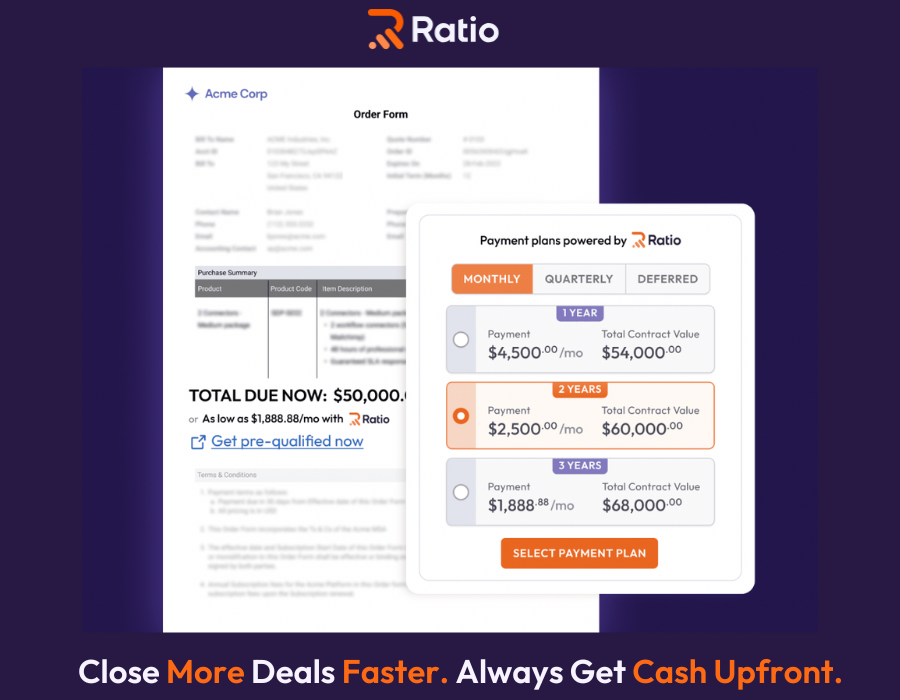
- ⚡ Dynamic Underwriting & Instant Approvals: AI-driven credit models automatically approve ~87% of deals in under a second—no friction, no manual review delays.
- 💸 Instant Upfront Payout (Minus a Small Fee): You get paid on Day 1 while your buyer pays over time. Ratio handles all collections and assumes the credit risk.
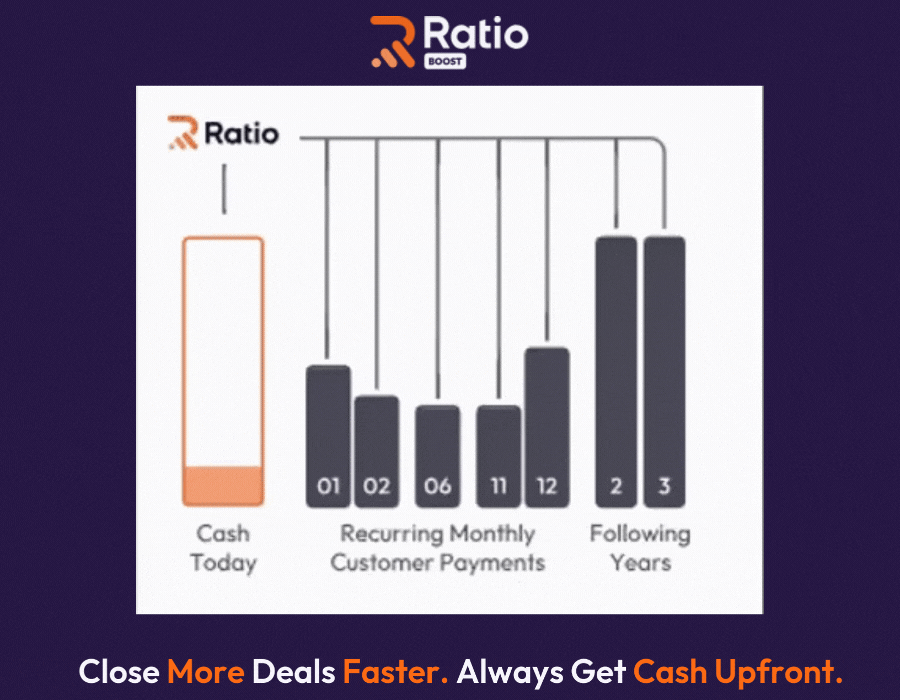
- 📄 Pre-Approved Terms Embedded in Contracts: No separate financing paperwork or delays. Terms are embedded and signed off in your standard agreements.
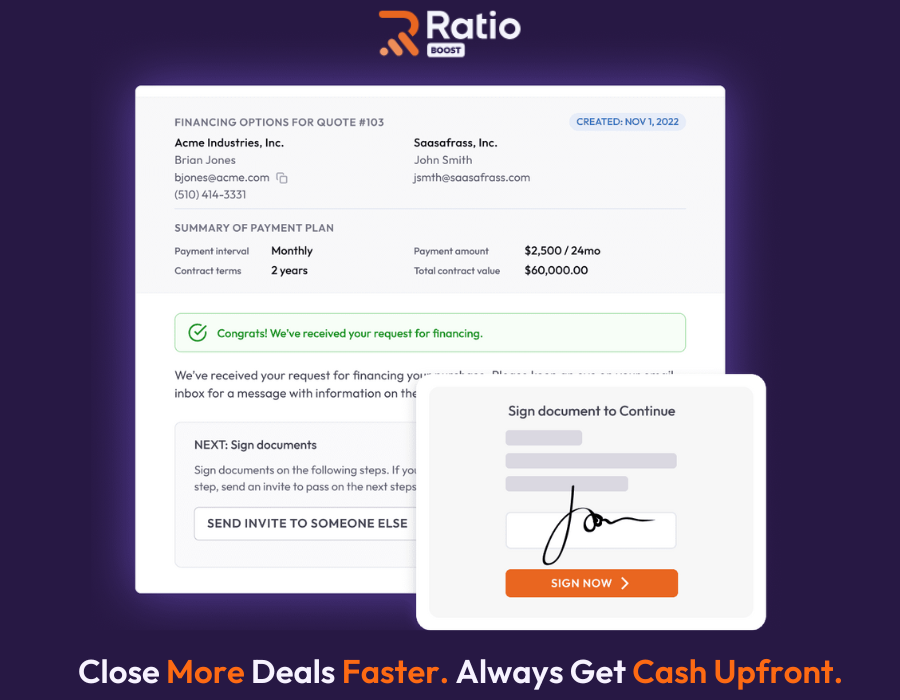
- 🤖 AI-Powered Deal Structuring: Ratio recommends payment terms and pricing based on buyer profile and deal risk—so reps can close with confidence without over-discounting.
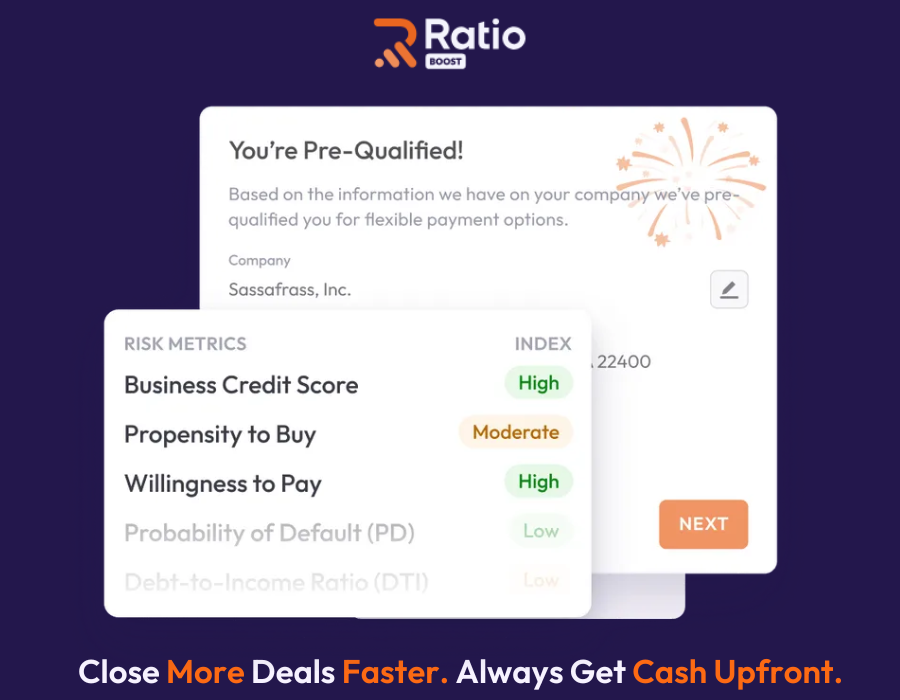
- 📊 Real-Time Deal Intelligence: See exactly where buyers stall during checkout and re-engage them in the moment to recover otherwise lost deals.
- 🔁 Flexible Mid-Term Upsells and Renewals: Add products, extend terms, or renew contracts mid-cycle without breaking the payment flow or renegotiating everything.
- ⚙️ Seamless CRM & Billing Integration: Works with Salesforce, HubSpot, Chargebee, Recurly, and your finance stack—no added workflows or manual handoffs.
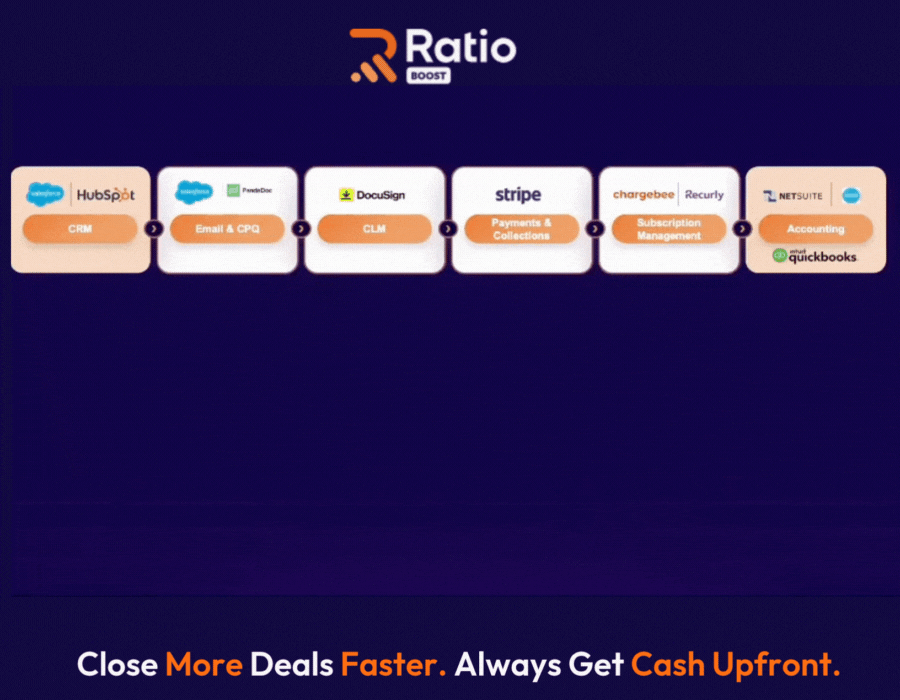
🔗 Integration Capabilities
Ratio Boost is designed to plug into your existing quote-to-cash ecosystem with minimal disruption. No data silos. No process rewrites.
CRM & Sales Platforms:
- Salesforce
- HubSpot
Billing & Subscription Tools:
- Chargebee
- Recurly
- Chargify
Accounting Systems:
- QuickBooks
- Xero
- Oracle NetSuite
- Sage
- FreshBooks
Payment & Banking Infrastructure:
- Stripe
- GoCardless
- ACHQ
- Plaid
The platform supports real-time sync and bi-directional data flows, ensuring pricing, contract, payment, and buyer status updates stay consistent across tools.
✔️ Pros
- Accelerates sales velocity by removing payment friction and approval delays
- Preserves cash flow with upfront payout on every deal
- Shifts repayment risk to Ratio, removing exposure from your books
- Integrates into CPQ and CRM workflows, requiring no rep behavior change
- Improves pricing power with AI-informed financing terms instead of discounts
- Supports complex SaaS models (subscription, milestone, hybrid) out of the box
❌ Cons
- Supports most SaaS pricing models out of the box; more complex structures like usage-based or tiered billing may require custom implementation
- SMB buyers tend to see the most value; some enterprise buyers may prefer using their own financing or procurement credit lines
- Custom term structuring beyond standard formats may require Ratio team support
🏆 Notable Clients
Ratio Boost is trusted by a growing roster of high-velocity SaaS companies across verticals like healthtech, fintech, logistics, and automation.
📈 Ratio recently reported 800%+ growth, driven by rising demand for embedded financing among modern B2B SaaS sellers.
Notable users include Motive, Taxwell, Lucid Bots, DearDoc, MarketJoy, and others.
💰 Pricing
Ratio Boost is free for SaaS sellers. Financing fees are only applied when a buyer opts for flexible terms, and they can be absorbed by you, passed to the buyer, or split based on deal strategy.

👉 Schedule a demo to model how financing fees impact your revenue and how different allocations affect close rates and CAC payback.
#2. Balance B2B – B2B Checkout with Built-In Payment Terms
Most payment platforms were built for eCommerce, not for B2B SaaS. Balance bridges that gap by offering flexible B2B payment terms at the point of checkout—without forcing merchants to delay revenue or chase collections.

It’s particularly effective for digital marketplaces, vertical SaaS platforms, and B2B sellers that want to offer net terms while getting funded instantly.
🚀 Key Features and Benefits
- 💸 Instant Seller Payout: Balance enables merchants to receive the full payment up front, even when buyers opt for net terms at checkout.
- 📆 Flexible Net Terms for Buyers: Supports 30-, 60-, or 90-day net terms for B2B buyers, embedded within the purchasing flow.
- 🧠 Real-Time Credit Checks & KYB: Balance performs credit and risk assessment during checkout, allowing qualified buyers to access net terms immediately.
- 🧾 Embedded in B2B Checkout: Financing and terms are offered inside the standard checkout—not through external portals or emails.
- 🔐 Built-in Risk & Compliance Management: Handles fraud detection, underwriting, and collections, reducing operational overhead for the merchant.
- 🔗 Multiple Payment Options: Buyers can pay via ACH, wire, card, or invoicing—based on merchant preference and buyer eligibility.
🔗 Integration Capabilities
- BigCommerce App Integration – Merchants can install Balance via the BigCommerce marketplace in minutes to enable B2B payments with net terms and instant payouts.
- SparkLayer for Shopify – Embedded B2B checkout experience with KYC, in-cart financing, and net-term qualification for Shopify/SparkLayer users.
- APIs & SDKs – Designed to integrate with custom checkout flows and B2B platforms through developer-friendly tools.
- RTP-Enabled ACH Rails – Instant bank connection and verification to speed up ACH payouts and reduce friction.
✔️ Pros
- Offering checkout-based net terms has boosted merchant conversion rates by up to 30%.
- Sellers receive payment immediately while buyers enjoy flexible terms.
- Built-in fraud checks, underwriting, KYC, and collections offload manual AR work.
- Accepts ACH, wire, credit card, and check in one checkout flow.
❌ Cons
- Lacks built-in support for CPQ workflows or custom SaaS quoting.
- Custom checkout flows need API/SDK integration resources.
- Focused on checkout terms—not subscription or milestone billing support —no current source.
🏆 Notable Clients
- Alibaba.com (SME) – Uses Balance to offer BNPL net terms at checkout across U.S. businesses.
- Material Bank, Bay Supply, Double Robotics, Bryzos, inBuild – B2B sellers and marketplaces using Balance via platforms like Shopify/SparkLayer.
💰 Pricing
Balance uses custom transaction-based pricing, typically charged to the seller, but negotiable or pass-through to buyers depending on each merchant’s strategy.
#3. FundThrough – Invoice Factoring for B2B Sellers
FundThrough is an embedded finance B2B platform that helps sellers unlock cash trapped in outstanding invoices. It connects directly to accounting platforms and pulls eligible invoices in real time, allowing businesses to get funded within 24 hours, instead of waiting 30–90 days for payment.

Unlike traditional lending, FundThrough operates within the seller’s existing systems (like QuickBooks or Xero), and embeds capital access into the accounts receivable process itself. That makes it embedded financing, not a separate workflow.
It’s specifically designed for B2B companies that invoice other businesses and want to convert net terms into instant cash, without chasing collections or assuming buyer risk.
🚀 Key Features and Benefits
- 💸 Instant Invoice Funding: Get up to 100% of the eligible invoice value in as little as 24 hours, turning receivables into working capital without waiting 30–90 days.
- 📊 Accounting System Integration: Connects directly to QuickBooks, Sage Intacct, and others to automatically import invoices—no manual uploads needed.
- 🔄 On-Demand Access:No contracts, no minimum commitments. You fund only the invoices you choose, when you need to.
- 📬 Collections Handled by FundThrough: They take on the buyer risk and follow up for repayment, so your team stays focused on growth.
🔗 Integration Capabilities
- Accounting Sync – Integrates with QuickBooks, Sage, Xero for invoice import and payment tracking.
- API Access – Enables embedding funding flows into custom platforms via developer APIs.
✔️ Pros
- Access funds often within one business day.
- Predictable fees i.e., Clear pricing structure avoids surprises.
- Minimal paperwork and no long-term commitments.
❌ Cons
- Invoices must be issued; not useful for pre-sale financing.
- Lacks integration with CPQ or subscription workflows.
🏆 Notable Clients
Used by small to mid-sized B2B service providers across the US and Canada.
💰 Pricing
2.2–3% flat fee per 30 days, with longer-dated invoices charged up to ~8.25%. No hidden fees, no minimum volumes.
#4. Stripe Capital – Embedded Working Capital for Stripe Merchants
Stripe-using SaaS and eCommerce merchants need flexible working capital—but traditional bank loans are slow, require credit checks, and don’t scale with revenue cycles.
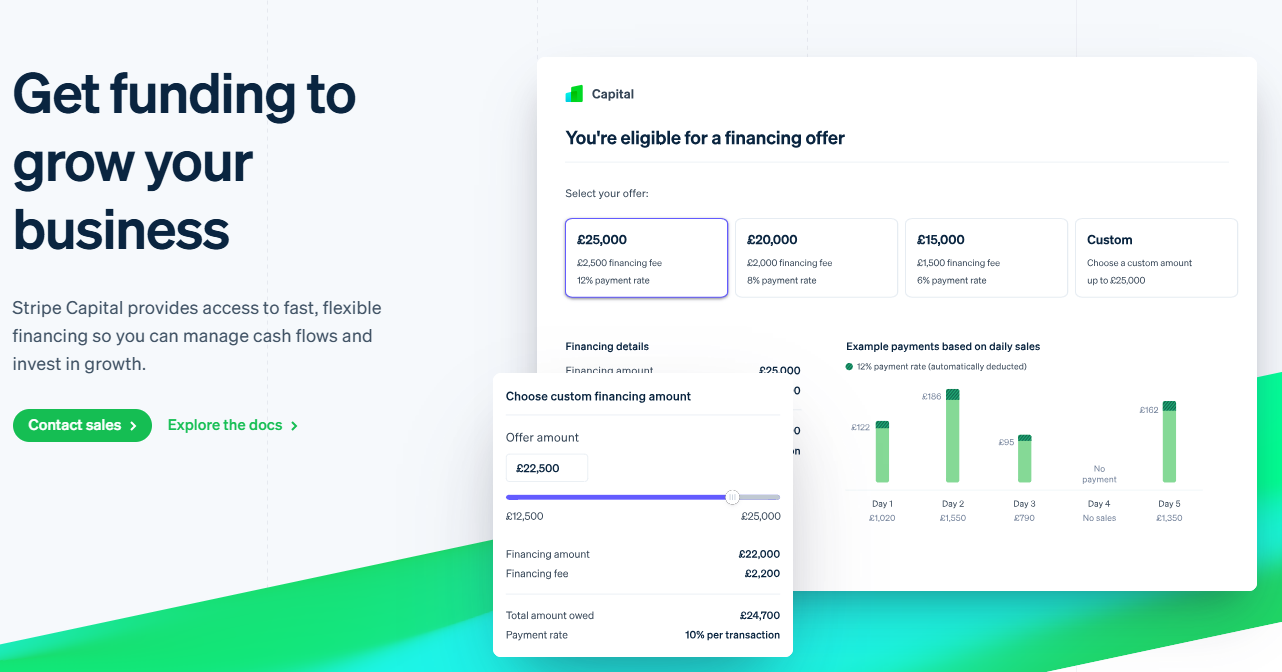
Stripe Capital uses Stripe transaction data to offer fast, personalized financing, with repayment automatically structured as a daily percentage of sales processed through Stripe.
🚀 Key Features and Benefits
- ⚡ Instant Working Capital for Stripe Users: Stripe automatically pre-approves eligible businesses based on transaction history—no application, no credit check, and no waiting weeks.
- 💰 Next-Day Funding: Once accepted, funds are deposited directly into your Stripe account—usually within one business day.
- 📉 Revenue-Based Repayment Model: You repay via a fixed percentage of daily Stripe sales. No monthly bills or late fees—payments flex with your cash flow.
- 🔒 Flat-Fee, No-Interest Pricing: Know your total repayment cost up front. No interest, origination fees, or prepayment penalties.
- 🧾 Fully Embedded in Stripe Dashboard: There’s no new platform to learn or manage—Capital is natively built into the Stripe experience.
Note: Stripe Capital does not offer embedded financing for your buyers (e.g. BNPL or term extension). It’s strictly a working capital solution for sellers.
🔗 Integration Capabilities
- Stripe Dashboard Native – Fully integrated within Stripe; no third-party setup, external logins, or APIs needed.
- Automatic Repayment Tracking – Deducted seamlessly from daily Stripe sales.
- Limited External Integration – Not designed to connect with CPQ, CRM, or subscription billing tools.
✔️ Pros
- Fast, Embedded Access to Funds Works directly within the Stripe dashboard for existing Stripe users.
- No Credit Check or Collateral Approval based solely on Stripe transaction history.
- Flexible Repayment Scales with your sales volume, easing cash flow pressure during slower months.
- Transparent Flat-Fee Pricing Know your total repayment upfront—no compounding interest or penalties.
❌ Cons
- Does not support flexible payment terms, BNPL, or milestone-based invoicing for your customers.
- Not available if you use other processors or billing platforms.
- Typically capped between $5,000–$150,000, based on transaction volume.
- Not Integrated with Sales Workflows No quoting, CRM, or checkout flexibility features.
🏆 Notable Clients
Used by small to mid-sized Stripe merchants across SaaS, eCommerce, and services.
Stripe does not publish specific customer case studies for Stripe Capital.
💰 Pricing
- Loan amounts: $5,000–$150,000 (based on transaction volume)
- Repayment: Daily percentage of Stripe sales (typically 5–20%)
- Fee structure: Flat fee (usually 6%–20%) disclosed upfront
- No interest, origination, or prepayment penalties
Now if we see, every platform we explored here tackles part of the sales-financing challenge.
But only one aligns with how modern SaaS teams sell, how buyers want to pay, and how finance needs to operate.
That platform is Ratio Boost and here’s why it stands apart.
🏆 Why Ratio Boost Is Literally the Best Embedded Finance B2B Platform Built for SaaS Complexity
You’ve seen the field.
Some platforms help you offer terms but leave you waiting for cash. Others give you capital but don’t plug into your sales process. And most ignore the nuance of how SaaS actually sells.
Ratio is the only platform that brings it all together — purpose-built for SaaS quote-to-cash velocity.
But here’s what truly sets it apart (and what most buyers miss):
🔹 Financing that scales with your pipeline: Ratio isn’t dependent on third-party lenders or bank approvals. With a $411M capital pool, it can fund every qualified deal your team closes without gating sales velocity.
🔹 Predictable revenue without pricing erosion: You don’t need to discount for upfront payments anymore. Ratio lets your buyers pay flexibly while you book full contract value immediately. That means stronger margins, cleaner forecasts, and no strain on finance.
🔹 Designed for how SaaS sells — not just how buyers pay: Whether your deals are rep-led or self-serve, priced by usage or milestones, Ratio adapts to your motion and your buyers’ expectations with zero friction.
That’s why companies like DearDoc, Motive, and Bigtincan rely on Ratio to remove the cash-flow drag from high-velocity SaaS sales.
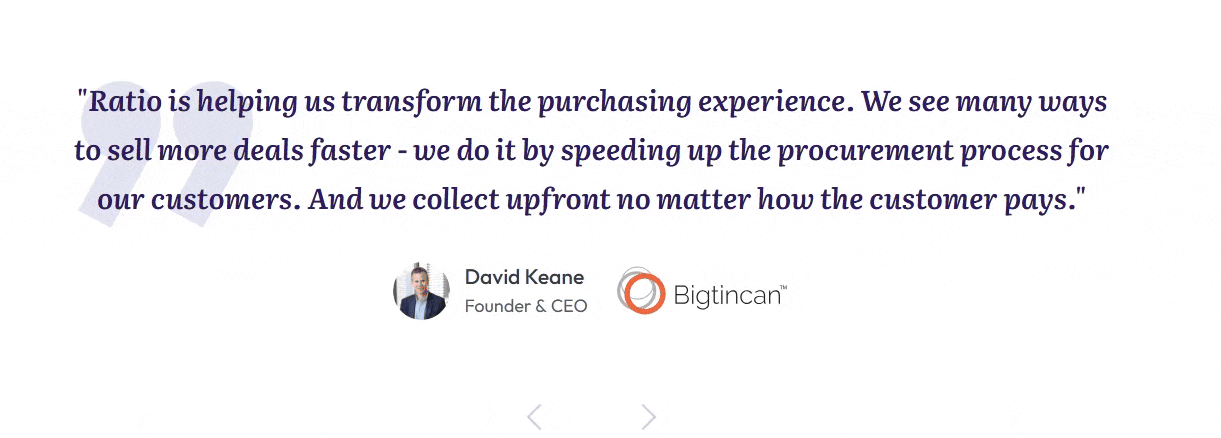
👉 Ready to stop losing deals over payment terms? Book a personalized walkthrough and see how Ratio helps you close faster, protect margin, and get paid on Day 1.
Disclaimer: All insights in this post are based on publicly available data, vendor websites, and user reviews as of our latest research. While we've prioritized accuracy and relevance for B2B SaaS decision-makers, we recommend validating features, pricing, and fit through vendor demos and tailored consultations before making a final selection.
FAQs — For more common questions, visit our product FAQs.
1. Can Embedded Finance Reduce the Need for Heavy Discounting in SaaS Sales?
Yes. Embedded finance lets buyers pay over time while sellers collect the full contract value upfront—eliminating the need for upfront payment discounts. This protects margins and shortens CAC payback cycles.
🔗 Learn more in How SaaS Businesses Benefit From Buy Now, Pay Later.
3. How Does Embedded Finance Improve CAC Payback and Cash Forecast Accuracy?
By turning signed contracts into instant cash, embedded finance compresses CAC payback and gives finance teams clearer, real-time visibility into cash position—removing delays caused by long payment cycles.
🔗 Discover the impact in CPQ + Embedded Financing: The SaaS Growth Stack You Didn’t Know You Needed.
4. What’s the Difference Between B2B BNPL and Embedded Invoice Financing?
B2B BNPL offers buyers structured terms (e.g., net-30/60) at the time of sale and gives sellers cash on day one. Invoice financing applies post-sale—sellers get paid only after generating and submitting an invoice. The former is sales-enabling; the latter is reactive.
🔗 Read more in Five Use Cases of B2B Embedded Finance for SaaS Businesses.








.png)



